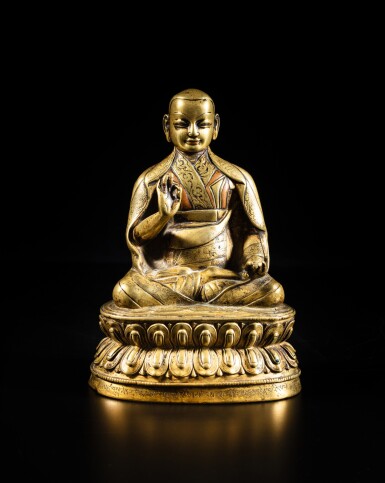Asian Arts / 5000 Years
Asian Arts / 5000 Years

PROPERTY FROM A BELGIAN PRIVATE COLLECTION | 比利時私人收藏
An inscribed silver and copper-inlaid copper-alloy figure of Sakya Lama, Tibet, 15th / 16th century | 十五 / 十六世紀 藏傳銅錯銀薩迦派喇嘛坐像
Lot Closed
December 12, 10:04 AM GMT
Estimate
20,000 - 30,000 EUR
We may charge or debit your saved payment method subject to the terms set out in our Conditions of Business for Buyers.
Read more.Lot Details
Description
Property from a Belgian Private Collection
An inscribed silver and copper-inlaid copper alloy figure of Sakya Lama
Tibet, 15th / 16th century
Himalayan Art Resources, item no. 15056.
Height 15.5 cm, 6⅛ in.
__________________________________________________________________________
Collection particulière belge
Statuette de Sakya lama en alliage de cuivre incrusté d'argent et de cuivre, Tibet, XVe / XVIe siècle
__________________________________________________________________________
比利時私人收藏
十五 / 十六世紀 藏傳銅錯銀薩迦派喇嘛坐像
HAR編號15056
The Sakya lama is seated with right hand in the gesture of teaching and discussion (vitarka mudra), and the lowered left hand indicating reassurance (abhaya mudra). The monastic sleeveless vest worn beneath the outer robe is inlaid in copper to simulate the red patchwork of the traditional Sakya garment, the hem with a deeply incised floral pattern. The double lotus pedestal is inscribed along the lower rim and sealed beneath with an undisturbed copper plate. The sculpture is distinguished by the craftsmanship in the deep relief of textile patterns and exquisite portraiture with copper and silver inlaid eyes and lips, cf. the relief patterns and metal inlay of a circa 1500 copper alloy Sakya Pandita, in Pal, Tibet: Tradition and Change, Albuquerque, 1997, pl. 24.
Transliteration and Translation by Jörg Heimbel:
ནམ་ཡང་བསླུ་མེད་དཀོན་མཆོག་གསུམ་གྱི་དངོས།།nam yang bslu med dkonmchog gsum gyi dngos||
མཁའ་མཉམ་འགྲོ་བ་མ་ལུས་འདྲེན་བའི་དཔལ།mkha’ mnyam ’gro ba ma lus ’dren ba’i dpal|
མཁྱེན་རབ་ཡོངས་སུ་སྫོགས་པའི་ཕྲིན་ལས་ཀྱིས།mkhyen rab yongs susdzogs pa’i phrin las kyis|
རྒྱལ་བའི་བསྟན་པ་གསལ་མཛད་དེ་ལ་འདུད།།rgyal ba’i bstan pa gsalmdzad de la ’dud||
དཀོན་མཆོག་མཆོད་པའི་སྤོབས་པ་ཅན།།dkon mchog mchod pa’ispobs pa can||
སོར་མོའི་འོད་ཟེར་རྩེ་ལས་འཁྲུངས།།sor mo’i ’od zer rtse las ’khrungs||
Corrections: ’dren ba’i = ’dren pa’i; sdzogs = rdzogs
Explanation: yongs su ཡོངས་སུ་ is written as a one-syllable abbreviation yongsu ཡོངསུ་
The personification of the Three Jewels that are alwaysinfallible,
The glory of the guide who leads all beings infinite as space
By the enlightened activity of fully perfected wisdom,
[I] bow to [you] who illuminates the teachings of the Victorious One.
[This statue] endowed with the inspiration of offering to the Three Jewels,
Is born from the tip of the light rays of [skillful] fingers.
[I] bow to [you] who illuminates the teachings of the Victorious One,
The personification of the Three Jewels that are always infallible,
The glory of the guide who leads all beings infinite as space
By the enlightened activity of fully perfected wisdom.
[This statue] endowed with the inspiration of offering to the Three Jewels,
Is born from the tip of the light rays of [skillful] fingers.
The first four lines are a praise of the depicted lama. Hidden within the praise is the name of the lama, which has to be pieced together from the individual syllables of the praise. Although difficult to identify with certainty, the praise may refer to Könchok Pel (dKon mchog dpal), Namkha Tenpa (Nam mkha' bstan pa) or Könchok Tenpa (dKon mchog bstan pa).
We are very grateful to Dr. Jörg Heimbel for his expertise and assistance for translating and researching the inscription on this statue, and also for his further assistance in researching lot 31.
